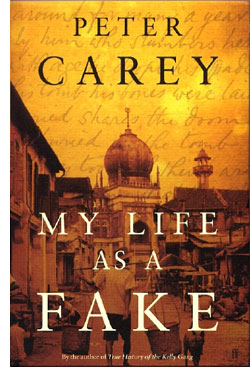My Life as a Fake
Peter Carey
Faber & Faber
UK Hardcover First
ISBN 0-571-21618-8
Publication Date: 11-01-2003
266 Pages; Price: £16.99
Date Reviewed: 20-11-03
Reviewed by: Katie Dean © 2003

REFERENCES
COLUMNS
|
|
|
My Life as a FakePeter CareyFaber & FaberUK Hardcover FirstISBN 0-571-21618-8Publication Date: 11-01-2003266 Pages; Price: £16.99Date Reviewed: 20-11-03Reviewed by: Katie Dean © 2003 |
|
|
REFERENCES |
COLUMNS |
Peter Carey's latest novel, 'My Life as a Fake', is based on a true incident that occurred in Australia in the 1940s. A reputable modern poetry magazine, 'Angry Penguins', published what it thought was a genuine poem written by a man recently deceased. Someone purporting to be the sister of the supposed poet, Ern Malley, sent the poem to the magazine editor along with some details about the man and his life. However, it soon transpired that the poem was in fact a fake and that Ern Malley had never existed. Two ex-soldiers were behind this hoax, claiming to be registering their personal protest against literary modernism in Australia. In a further cruel twist, the editor of the magazine suffered not only wounded pride, but also found himself in court facing a charge of publishing obscenities. However, the fact that Ern Malley had never existed and that his alleged poems were no more than nonsense, did not prevent them from becoming widely read.
Peter Carey has taken this incident that made such an impression on him in his youth and woven it into a fascinating story that looks at events from the perspective of the prank's authors. Carey mixes fact and fiction, borrowing the actual lines of poetry first published in 'Angry Penguins', but the fictitious poet is renamed Bob McCorkle and the author of the ruse becomes a single man, Christopher Chubb. Carey's book is set in Kuala Lumpur in the 1970s where Chubb now resides, a social outcast and a broken man. For anyone who is already familiar with the Ern Malley incident, the first few chapters of Carey's novel may seem very familiar. However, Carey is not so much concerned with the incident itself as with some of the issues it raises.
The central idea behind Carey's novel is the way in which the creation of something inanimate, in this case a poem, can generate its own life. In the original Ern Malley incident, the fake poems generated their own followers and criticism, gaining a 'life' independent of their authors. Carey takes this idea and weaves it into the central theme for his novel. Christopher Chubb thinks he is only writing a set of fake poems in order to teach an old school fellow (David Weiss) a lesson. However, aside from the dire consequences suffered by David as editor and publisher of the fake works, Chubb finds himself haunted by a man claiming to actually be the fictitious poet, Bob McCorkle. In this sense, Carey's work self-consciously mirrors the idea of Frankenstein, the thoughtless creator goaded by his creation. Bob McCorkle is more than just a Frankenstein monster, he also becomes the central mystery in Chubb's life. Who was this man? Did he in fact exist or was he simply a figment of Chubb's guilty imagination? The reader is left to reach his or her own conclusion.
In yet another complex twist, Carey tells his story through an English poetry magazine editor, Sarah Wode-Douglass. Whilst traveling in Kuala Lumpur, Sarah meets Christopher Chubb and is shown one of Bob McCorkle's poems. This is not one of the original fakes, but a poem written by the man who has taunted Chubb, or so Chubb insists. In a twisted reflection of the original incident, Sarah, despite being aware of the original hoax, believes the poem she has been shown to be a work of genius and becomes obsessed by the desire to publish it in her magazine. In order to do so, she finds herself forced to listen to Chubb's story, eventually being drawn into his life with rather unexpected consequences.
'My Life as a Fake', like any well-written novel, offers interesting, believable characters, well-drawn settings and a compelling story. More importantly, it also offers a clever plot that will leave its readers with much to think about. Whilst this is a thoroughly enjoyable novel for anyone, it offers most to those readers familiar with the outline of the Ern Malley hoax. Carey masterfully mixes fact and fiction, parodies the original incident and draws out the real points of interest from this infamous literary hoax.